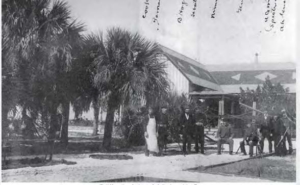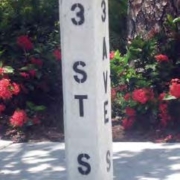It Cements Our Sense of Place

Lois Bolin, PhD, Old Naples Historian
Neither snow, nor rain, nor heat, nor gloom of night stays these courageous couriers from the swift completion of their appointed rounds.” Contrary to what many people think, those words did not originate with the United States Postal Service.
They were etched on the James Farley Post Office in New York City in 1898, but they were derived from a quote by Herodotus, who was inspired by the brave couriers he observed during the Greco-Persian Wars some 2,500 years ago. Mail delivery in Florida’s final frontier was not without its challenges, although Herodotus might not have seen it that way.
Over land or water, Naples had service
Captain Charles Stewart wore many hats during his employment by Walter Haldeman, the founder of Naples. One of those hats was as the skipper of the Bon Temp, the steamboat that delivered the mail and another was as the postmaster. The town’s first post office (1908) was at Capt. Stewart’s house on 12th Avenue South, and later moved to the end of the pier. Herodotus no doubt would have scoffed at this notion. Ansel McSwain, who later became Mayor of Bonita Springs and one of the co-founders of the Bank of Naples, was the area’s first and only Pony Express rider. In the morning, he’d carry the mail to Naples from Bonita Springs, and at night, he’d take the mail back to Bonita Springs. Perhaps Herodotus would have considered saddle sores a hazard of duty.
Here today, gone tomorrow
 The paradox of progress is hard to swallow when the place we love has to change. Our sense of place is what orients us and provides context for our lives. We are all a part of the places we live within, and when those places are destroyed, a part of us dies with them. Some say that our sense of place comes from making a living from “it,” suffering from “its” catastrophes, valuing “it” for the investment of hard labor that we, our parents and grandparents and perhaps our unknown ancestors have put into “it.” One’s sense of Naples, as it relates to providing a context for our lives, depends upon when “it” became your full time home — not a tax shelter, but your home.
The paradox of progress is hard to swallow when the place we love has to change. Our sense of place is what orients us and provides context for our lives. We are all a part of the places we live within, and when those places are destroyed, a part of us dies with them. Some say that our sense of place comes from making a living from “it,” suffering from “its” catastrophes, valuing “it” for the investment of hard labor that we, our parents and grandparents and perhaps our unknown ancestors have put into “it.” One’s sense of Naples, as it relates to providing a context for our lives, depends upon when “it” became your full time home — not a tax shelter, but your home.
A few years ago, I had a phone call from a Naples-born friend, Denyse Smith Mesnick, granddaughter of Roy Smith, longest running Mayor of Naples and co-founder of the Bank of Naples. asking for my help in saving the city’s last remaining concrete street marker — all 400 pounds of it.
Ms. Mesnick had received a tip that the city was concerned about the Third Street South/Third Avenue South marker and had plans to remove it.
When the postman in the early 1940s said his route was getting too big and the town needed some kind of street marker with numbers, the residents agreed. Up until this time, the mail carrier knew the houses along his route by the colors and tile designs on the individual roofs.
The Chamber of Commerce decided it would donate the markers and made a plan to install 136 of them around the town. That was in 1948. It took four years before any of the $2-apiece markers were put in their proper places.
Back again
 Over the years, the street markers gradually disappeared, most likely due to demolitions and re-dos. The post at Third St. S. and Third Ave. S. stood firmly in place watching over the home of Ms. Mesnick’s family friends, Preston and Margaret Tuttle. When Margaret passed away in 2005 at the age of 95, the house was sold. With demolition crews on their way, George Archibald, the city’s traffic engineer, saved the day by saving the marker and storing it for safekeeping. Once freshly painted, it was returned to its rightful spot, now distinguished with a marker of its own declaring: “Naples Landmark Street Marker circa 1948. Former site of the home of Preston and Margaret Tuttle 1945-2005.”
Over the years, the street markers gradually disappeared, most likely due to demolitions and re-dos. The post at Third St. S. and Third Ave. S. stood firmly in place watching over the home of Ms. Mesnick’s family friends, Preston and Margaret Tuttle. When Margaret passed away in 2005 at the age of 95, the house was sold. With demolition crews on their way, George Archibald, the city’s traffic engineer, saved the day by saving the marker and storing it for safekeeping. Once freshly painted, it was returned to its rightful spot, now distinguished with a marker of its own declaring: “Naples Landmark Street Marker circa 1948. Former site of the home of Preston and Margaret Tuttle 1945-2005.”
Four years later, this small, sense of place marker, was under siege again. Here we are in 2021 and “it” is still there. You have probably passed “it” on your way to Sea Salt or the Naples Pier. Perhaps when you ride by now, you will see “it” in a different way and tell the story of how “it” came to be thus adding a layer to your own sense of place.



Leave a Reply
Want to join the discussion?Feel free to contribute!